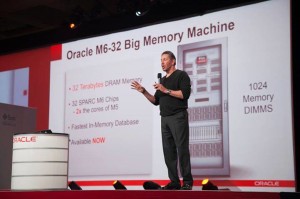 Database Giant, Oracle is looking to take advantage of CPU, DRAM, and Flash memory architectures to deliver in-memory solutions that enhance transaction processing and analytics. Along these lines, Oracle highlighted a comprehensive in-memory solution stack including the inmemory Exalytics appliance, in-memory middleware and business analytics, in-memory data cache (Times Ten) and the Oracle in-memory data grid (through Coherence), the inmemory
Database Giant, Oracle is looking to take advantage of CPU, DRAM, and Flash memory architectures to deliver in-memory solutions that enhance transaction processing and analytics. Along these lines, Oracle highlighted a comprehensive in-memory solution stack including the inmemory Exalytics appliance, in-memory middleware and business analytics, in-memory data cache (Times Ten) and the Oracle in-memory data grid (through Coherence), the inmemory
database (Times Ten) and an in-memory compute platform.
In-memory option for the Oracle 12c Database. With this option, the company expects to drive 100x faster queries and real-time analytics against OLTP or data warehouses, while also doubling transaction processing rates (i.e. insert rows 3-4x faster). In part, these improvements are enabled by the 12c database’s ability to store data in both row (optimized for transaction processing) and column format (optimized for analytics) simultaneously, referred to as a dual format, and also the result of parallel processing in main memory. Of note, the oracle in-memory option does not require any application changes given: i) there are no restrictions on SQL, ii) does not require data migration, iii) works with existing apps, and iv) is cloud ready.
M6-32 Big Memory Machine – The new system has 32TB of DRAM and 32 SPARC M6 chips that have 2x the number of cores of M5 systems (the new M6 CPU has 12 cores and 96 threads per processor).
Oracle Cloud Strategy
Management laid out Oracle’s cloud strategy, which spans across Infrastructure-asa-Service (IaaS), Platform-as-a-Service (PaaS) and Software-as-a-Service (SaaS). Oracle’s public cloud today supports nearly 15K organizations with 21.5mn users enabling 19bn transactions daily from 13 data centers worldwide. Oracle highlighted nearly 2mn users of cloud-based Fusion applications today. Other elements of the Oracle IaaS cloud include identity, caching, messaging and synching. With its PaaS, Oracle delivers a full set of application development technologies via the cloud including Java as well as developer and mobile services (agile development, cross-platform mobile apps).
The company is also in the final stages with its documents and business intelligence services for document sharing/team workspace and self-service analytics and reporting. In addition, the company offers a Cloud Marketplace for SaaS customers or ISVs running applications through ORCL’s cloud (100s of applications and 160 key partners today). Further with its database-as-a-service option, customers can take advantage of cloud-based instances of the 11gR2 or 12c database, which Oracle believes can help customers reduce the cost of managing databases on premise.